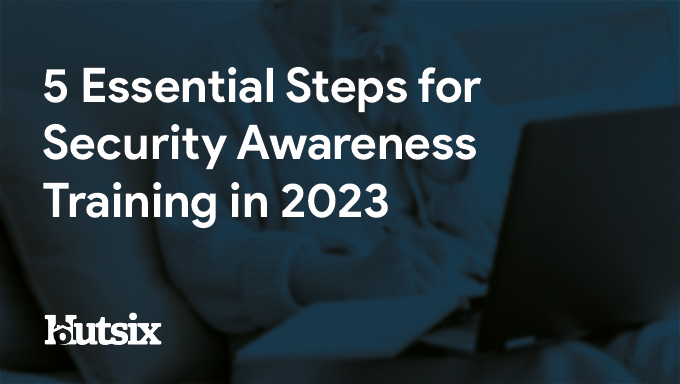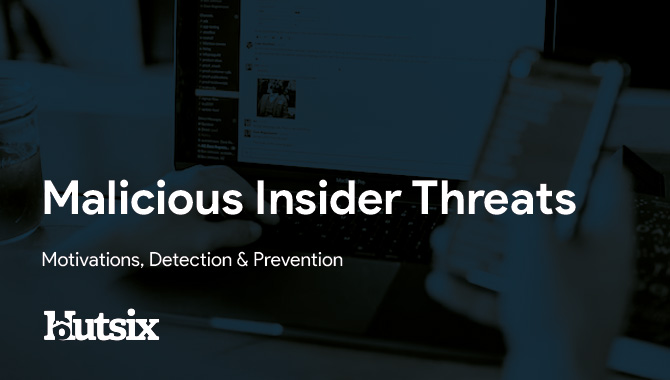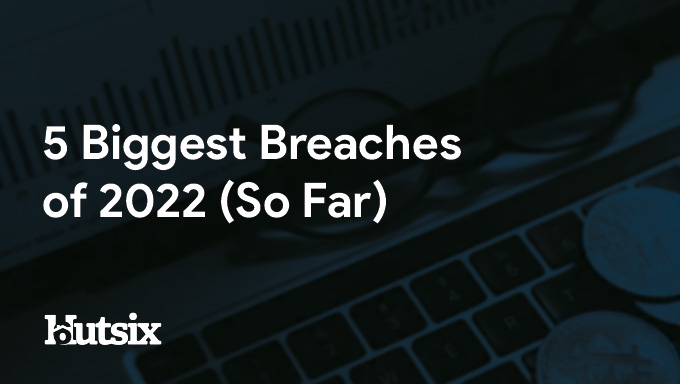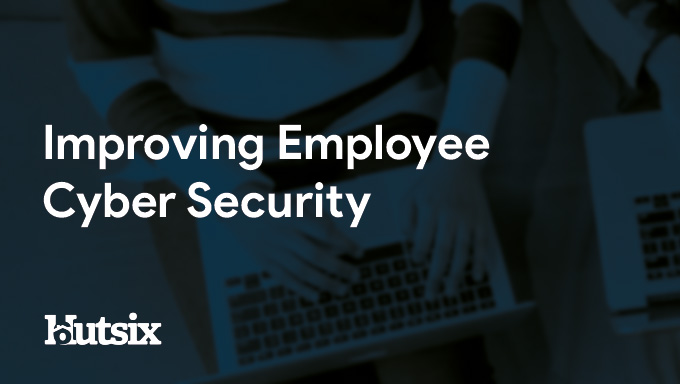15 Essential Cyber Awareness Training Topics for 2024
In 2024, information security is not just a buzzword but a fundamental necessity. As we embrace the dynamic challenges of an evolving landscape of digital threats, Hut Six presents ‘15 Essential Security Awareness Training Topics for 2024'.
These topics are not just information; they are shields against the myriad cyber threats lurking in the shadows. From the craftiness of phishing attacks to the complexities of cloud security, each topic plays a pivotal role in fortifying individuals and organisations against digital adversaries.
Join us as we delve into the significance of these 15 training areas, understanding why they are indispensable in an era where safeguarding sensitive data and digital assets is paramount.
Welcome to the world of security awareness in 2024, where knowledge is the ultimate defence.
Looking for cost effective security training?
Talk to one of our experts about effective training in 2024.
What Should Security Awareness Training Included?
Phishing Attacks
Phishing is a deceptive cyberattack where malicious actors impersonate legitimate entities, often through emails or websites, to trick individuals into revealing sensitive information, such as login credentials, financial details, or personal data.
It's an essential training topic because phishing attacks continue to be a prevalent and highly effective method for cybercriminals; as such, employees who can recognise and respond to phishing attempts are a critical line of defence for organisations.
Learn more about using phishing simulation to test employees.
Phishing awareness training equips them with the skills to identify suspicious emails, URLs, or social engineering tactics, reducing the risk of falling victim to these scams.
By understanding the tactics used by phishers, employees become a crucial part of an organisation's cybersecurity posture, helping to safeguard sensitive information and prevent data breaches.
Password Security
Password security involves the implementation of practices and measures to protect the confidentiality and integrity of passwords, which are used to access various digital accounts and systems. It's an essential training topic due to the central role passwords play in safeguarding sensitive information.
Password security training educates individuals on creating strong, unique passwords, avoiding common pitfalls (like using easily guessable passwords), and the importance of regularly updating and managing their passwords.
Check out our free secure password generator!
Cybercriminals often target weak passwords in their attempts to breach accounts, making password security crucial to overall cybersecurity.
Effective password management reduces the risk of unauthorised access, data breaches, and identity theft, ensuring that individuals and organisations can maintain the confidentiality and integrity of their digital assets and sensitive information.
Social Engineering
Social engineering is a manipulative technique employed by cybercriminals to exploit human psychology and trick individuals into divulging sensitive information or performing actions that compromise security. It's a critical training topic because it targets the weakest link in cybersecurity: people.
Social engineering tactics include pretexting (creating a fabricated scenario), baiting (enticing victims with something desirable), and tailgating (gaining unauthorised access by following someone).
Hut Six's Social Engineering Tutorial
Training in social engineering awareness helps individuals recognise and resist these tactics, fostering a more security-conscious workforce.
By understanding the principles of social engineering and how to spot red flags, employees can become a robust defence against attacks that rely on basic human error.
This training reduces the likelihood of data breaches, unauthorised access, and other security incidents, ultimately safeguarding an organisation's sensitive information and assets.
Mobile Device Security
Mobile device security pertains to safeguarding smartphones, tablets, and other portable gadgets from threats like data breaches, malware, and unauthorised access. It's a vital training topic due to the ubiquitous use of mobile devices in both personal and professional settings.
Training in mobile device security teaches individuals how to protect their devices through actions like setting strong PINs or passcodes, enabling encryption, and regularly updating operating systems and apps.
Get a taste of Hut Six training with the FREE Cyber Short Tutorial
With the increasing reliance on mobile devices for work-related tasks, the risk of data exposure and unauthorised access is significant.
Mobile device security training ensures that employees understand the importance of securing these devices to prevent data leaks, maintain privacy, and protect sensitive company information. By learning to identify and mitigate mobile security risks, individuals contribute to a more robust overall cybersecurity posture for their organisation.
Data Privacy Regulations
Data Privacy Regulations are legal frameworks that govern the collection, use, storage, and protection of individuals' personal data by organisations. These regulations, such as the General Data Protection Regulation (GDPR) and the California Consumer Privacy Act (CCPA), are essential training topics because they have a profound impact on how businesses handle sensitive information.
Training on data privacy regulations is crucial to ensure compliance and avoid hefty fines and legal consequences. Employees need to understand their roles in protecting customer and employee data, including obtaining proper consent for data processing, responding to data subject requests, and reporting data breaches promptly.
Moreover, with an increasing global focus on data privacy, organisations must uphold ethical standards and build trust with customers and partners. Training in data privacy regulations equips employees with the knowledge and skills to navigate this complex landscape, safeguard personal data, and maintain the reputation and credibility of the organisation.
Ransomware Prevention
Ransomware prevention refers to the set of proactive measures and practices aimed at thwarting ransomware attacks, where malicious software encrypts a victim's data, demanding a ransom for its release. It's a critical training topic due to the increasing frequency and devastating consequences of ransomware incidents.
Training in ransomware prevention educates individuals on recognising suspicious emails or links, practicing safe browsing habits, and regularly backing up data. By understanding the tactics used by ransomware attackers and how to avoid falling victim to them, employees can play a pivotal role in protecting their organisation's data.
Ransomware attacks can lead to data loss, operational disruptions, and financial losses. Effective training empowers employees to be vigilant, take preventative actions, and report potential threats promptly. This collective effort significantly reduces the risk of falling prey to ransomware, safeguarding an organisation's critical data and minimising the impact of potential attacks.
Malware Awareness
Malware awareness involves educating individuals about the various types of malicious software (malware) and how to recognise, prevent, and respond to malware threats. It's a crucial training topic because malware remains a persistent and evolving cybersecurity menace.
Training in malware awareness teaches employees to identify suspicious files, links, or attachments in emails and to understand the risks associated with downloading content from untrusted sources.
Awareness of malware types, such as viruses, Trojans, and spyware, enables individuals to take proactive measures to protect their devices and data.
Malware can lead to data breaches, financial losses, and system disruptions. By fostering malware awareness, organisations empower their workforce to be proactive in defending against these threats, reducing the likelihood of malware infections and minimising the potential impact on the organisation's cybersecurity and operations.
Remote Work Security
Remote work security refers to the practices and measures implemented to protect the confidentiality, integrity, and availability of data and systems while employees work remotely, often outside the traditional office environment. It's a critical training topic because remote work has become increasingly prevalent, making organisations more vulnerable to security risks.
Training in remote work security educates employees on secure remote access methods, the importance of using virtual private networks (VPNs), and the safe handling of sensitive data outside the office.
With remote work environments being less controlled, the risk of data breaches, unauthorised access, and cyberattacks escalates.
Ensuring remote workers are well-versed in security measures helps organisations maintain data security and compliance, even when employees are working from various locations. By promoting secure remote practices, organisations can minimise the risks associated with remote work, safeguard their sensitive information, and maintain business continuity.
IoT Security
IoT (Internet of Things) security refers to the measures and protocols put in place to protect the interconnected network of physical devices, sensors, and objects that communicate and share data over the internet. It's a crucial training topic because the proliferation of IoT devices has expanded the attack surface for cyber threats.
Training in IoT security educates individuals on the risks associated with IoT devices, including vulnerabilities that can be exploited by cybercriminals. It emphasises the importance of changing default passwords, applying security updates, and configuring IoT devices securely.
Weaknesses in IoT security can lead to unauthorised access, data breaches, and even physical harm in critical applications like healthcare and infrastructure. Training in this area equips individuals to recognise and mitigate IoT security risks, enhancing the overall cybersecurity posture of organisations and protecting against potential IoT-related threats.
Multi-Factor Authentication (MFA)
Multi-Factor Authentication (MFA) is a security method that requires individuals to provide two or more separate authentication factors before gaining access to an account or system. These factors typically include something the user knows (e.g., a password), something they have (e.g., a smartphone or security token), and something they are (e.g., a fingerprint or facial recognition).
MFA is an essential training topic because it significantly enhances account security.
Training in MFA educates individuals on how to set up and use this additional layer of protection. It reinforces the importance of MFA in preventing unauthorised access, even if passwords are compromised. MFA is highly effective in reducing the risk of account breaches and data theft, making it a critical component of a robust cybersecurity strategy.
Physical Security
Physical security refers to the measures and protocols implemented to safeguard an organisation's physical assets, premises, and personnel from unauthorised access, theft, vandalism, or harm. It's a vital training topic because breaches in physical security can lead to significant losses, data breaches, or disruptions in operations.
Training in physical security covers topics such as access control, surveillance, visitor management, and emergency response procedures. Employees learn how to identify and report suspicious activities, secure their workspaces, and respond effectively to security incidents.
Find out more about our Fundamentals Physical Security Tutorial
Effective physical security training helps protect an organisation's physical assets, sensitive information, and employees. It ensures that individuals understand their role in maintaining a safe and secure environment, reducing the risk of physical breaches, theft, or harm to personnel. Additionally, it contributes to regulatory compliance and business continuity planning.
Social Media Safety
Social media safety involves educating individuals about the risks and best practices associated with using social networking platforms. It's an essential training topic because the widespread use of social media exposes individuals and organisations to various cybersecurity and privacy threats.
Get a taste of Hut Six training with the FREE Cyber Short Tutorial
Training in social media safety covers topics such as setting strong privacy settings, recognising, and avoiding phishing attempts on social media, and being cautious about sharing personal or sensitive information online. It also addresses the potential consequences of oversharing or engaging with malicious actors on these platforms.
Social media is a common vector for cyberattacks, identity theft, and reputational damage. Effective training in social media safety equips individuals with the knowledge and skills to protect their personal and professional online presence, reduce the risk of falling victim to social media-related threats, and maintain a positive and secure digital footprint.
Incident Response
Incident response is a structured approach to addressing and managing security incidents, such as data breaches, cyberattacks, or system vulnerabilities. It's a critical training topic because a well-prepared and coordinated response is essential to minimising the impact of security incidents.
Training in incident response equips individuals with the skills and knowledge to detect, report, and respond to security incidents promptly and effectively. It covers areas like incident identification, containment, eradication, and recovery.
Incident response training is essential because it ensures that organisations can swiftly and efficiently mitigate security threats, minimise data breaches, and limit financial and reputational damage.
By having well-trained incident responders, organisations can maintain customer trust, comply with legal requirements, and protect their assets and sensitive information in the face of evolving cybersecurity threats.
Security Updates and Patching
Security updates and patching involve the process of regularly applying software updates, patches, and fixes to address known vulnerabilities in operating systems, applications, and other software. It's a crucial training topic because staying current with these updates is fundamental to maintaining the security of digital systems and data.
Training in security updates and patching educates individuals about the importance of promptly installing updates and patches. It covers topics like identifying and prioritising critical updates, testing patches, and scheduling maintenance windows.
Failure to keep systems up to date can leave them vulnerable to exploitation by cybercriminals. Training in this area is essential as it helps prevent security breaches, data theft, and system compromises by ensuring that employees are well-informed about the significance of timely updates and patch management in maintaining robust cybersecurity defences.
Cloud Security
Cloud security encompasses the practices and measures implemented to protect data, applications, and resources stored in cloud computing environments. It's a critical training topic because businesses increasingly rely on cloud services, making it essential to understand and manage the associated security risks.
Training in cloud security covers topics such as data encryption, access control, identity management, and compliance with cloud-specific security standards. It helps individuals understand how to securely configure and use cloud services, recognise potential threats, and respond to cloud-related security incidents.
Cloud security training is vital because mishandling cloud resources can lead to data breaches, unauthorised access, and compliance violations. By educating employees about cloud security best practices, organisations can ensure the safe adoption of cloud technologies, protect sensitive data, and maintain the confidentiality and integrity of information stored in the cloud.
Hut Six Training
Any organisation can fall victim to an information security incident. Despite technical precautions that help mitigate this risk, your employees are the most immediate and vulnerable target for malicious actors - and your first line of defence.
Now more than ever, you rely on your people making the correct choices in the face of security decisions. Thankfully, with the right knowledge, many of these human vulnerabilities can be easily addressed.
Hut Six's Security Awareness Training solution reduces the risk of a successful cyber-attack. Preventing financial losses, damage to reputation, potential fines, and litigation, robust and engaging information security training is an essential for any organisation looking to improve their information security culture.
Security Awareness for your Organisation
Enjoyed our blog? Learn more about how Hut Six can help improve you security awareness with training and simulated phishing. Start a free trial now, or book a meeting with one of our experts.
Featured
What is the Impact of Security Awareness Training? - Hut Six
Discover the Impact of Security Awareness Training: Prevent breaches, foster culture, & build trust.
What is Personal Data?
Learn about personal data, its types, and significance in data protection. Explore general and special category data, as well as pseudonymised and anonymised data under the GDPR.
Who Does GDPR Apply To?
Who Does GDPR Apply To? And Other Data Protection Questions/ Information Security blog by Information security awareness provider Hut Six Security.
Does ChatGPT Pose a Cybersecurity Risk
In this blog post, we explore whether AI chatbots like ChatGPT pose a cybersecurity risk. We delve into the potential vulnerabilities and threats posed by chatbots, and discuss measures that can be taken to mitigate these risks. Read on to discover how you can ensure the security of your organisation's chatbot interactions.
How Do I Get Cyber Essentials Certified?
Learn how to obtain Cyber Essentials certification and enhance your organization's cybersecurity posture with our comprehensive guide. Our expert insights will help you navigate the certification process to meet the requirements for Cyber Essentials.
Essential Steps for Security Awareness Training
Starting a security awareness training campaign? Here are 5 essential steps to help ensure information security success.
Malicious Insider Threats - Meaning & Examples
Malicious insider threats can cause massive problems. Here we examine some of the motivations behind attacks and methods of detection organisations can use to reduce risk.
5 Biggest Breaches of 2022 (So Far)
Five of the biggest and most significant data breaches, hacks, and information security attacks of 2022 (so far).
Auditing for GDPR Compliance
Questions to consider when auditing your business or SME for General Data Protection Regulation (GDPR) compliance.
Improving Employee Cyber Security
With human error responsible for many breaches and attacks, we offer some helpful areas for improving employee security compliance.












